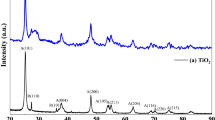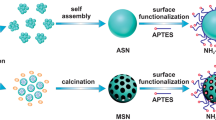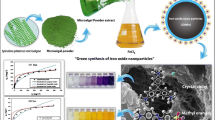Abstract
Herein, we prepared the silica nanoparticles (SiO2 NPs) by a modified Stober’s method for methyl orange (MO) removal. The SiO2 NPs were found to be spherical with a zeta size of 152.5 d. nm, a PDI of 0.377, and a zeta potential of −5.59 mV. The effect of different parameters (initial dye concentration, reaction time, temperature, and pH) on the adsorption of MO by SiO2 NPs was determined. The adsorption pattern of SiO2 NPs was highly fitted with the Langmuir, Freundlich, Redlich-Peteroen, and Temkin isotherm models. The highest adsorption rate was recorded at 69.40 mg/g of SiO2 NPs. Furthermore, the toxic effect of before and after removal of MO in aqueous solution was tested in terms of phytotoxicity and acute toxicity. The SiO2 NPs treated MO dye solution were not exhibited significant toxicity to corn seeds and Artemia salina. These results indicated that SiO2 NPs can be used for the adsorption of MO.







Similar content being viewed by others
Data availability
The data generated and analyzed during the current study are available from the corresponding author on reasonable request.
References
Abdelgawad AM, El-Naggar ME, Eisa WH, Rojas OJ (2017) Clean and high-throughput production of silver nanoparticles mediated by soy protein via solid state synthesis. J Clean Prod 144:501–510
Abdul Mubarak NS, Chuan T, Khor H, Jawad AH, Wilson L, Sabar S (2021) Immobilized Fe-loaded chitosan film for methyl orange dye removal: competitive ions, reusability, and mechanism. J Polym Environ 29:1050–1062
Abdullah MA, Chiang L, Nadeem M (2009) Comparative evaluation of adsorption kinetics and isotherms of a natural product removal by Amberlite polymeric adsorbents. Chem Eng J 146:370–376
Ahmad A, Razali MH, Mamat M, Mehamod FSB, Amin KAM (2017) Adsorption of methyl orange by synthesized and functionalized-CNTs with 3-aminopropyltriethoxysilane loaded TiO2 nanocomposites. Chemosphere 168:474–482
An L, Si C, Bae JH, Jeong H, Kim YS (2020) One-step silanization and amination of lignin and its adsorption of Congo red and Cu (II) ions in aqueous solution. Int J Biol Macromol 159:222–230
Asuha S, Zhou X, Zhao S (2010) Adsorption of methyl orange and Cr (VI) on mesoporous TiO2 prepared by hydrothermal method. J Hazard Mater 181:204–210
Bajpai N, Tiwari A, Khan S, Kher R, Bramhe N, Dhoble S (2014) Effects of rare earth ions (Tb, Ce, Eu, Dy) on the thermoluminescence characteristics of sol–gel derived and γ-irradiated SiO2 nanoparticles. Luminescence 29:669–673
Balarak D, Mahdavi Y, Bazrafshan E, Mahvi AH (2016) Kinetic, isotherms and thermodynamic modeling for adsorption of Acid Blue 92 (AB92) from aqueous solution by modified Azolla filicoloides. Fresen Environ Bull 25:1322–1331
Bazrafshan E, Zarei AA, Nadi H, Zazouli MA (2014) Adsorptive removal of methyl orange and reactive red 198 dyes by Moringa peregrina ash. Indian Journal of Chemical Technology 21(2):105–113
Belayachi H, Bestani B, Benderdouche N, Belhakem M (2019) The use of TiO2 immobilized into grape marc-based activated carbon for RB-5 Azo dye photocatalytic degradation. Arab J Chem 12:3018–3027
Chen S, Zhang J, Zhang C, Yue Q, Li Y, Li C (2010a) Equilibrium and kinetic studies of methyl orange and methyl violet adsorption on activated carbon derived from Phragmites australis. Desalination 252:149–156
Choi E, Kim S (2019) Surface pH buffering to promote degradation of mesoporous silica nanoparticles under a physiological condition. J Colloid Interface Sci 533:463–470
Dhakate P, Kandhol N, Raturi G, Ray P, Bhardwaj A, Srivastava A, Kaushal L, Singh A, Pandey S, Chauhan DK (2022) Silicon nanoforms in crop improvement and stress management. Chemosphere 305:135165
Dubey R, Rajesh Y, More M (2015) Synthesis and characterization of SiO2 nanoparticles via sol-gel method for industrial applications. Mater Today: Proc 2:3575–3579
Elgarahy AM, Elwakeel KZ, Mohammad SH, Elshoubaky GA (2021) A critical review of biosorption of dyes, heavy metals and metalloids from wastewater as an efficient and green process. Clean Eng Technol 4:100209
Elwakeel K, El-Bindary A, Ismail A, Morshidy A (2016) Sorptive removal of Remazol Brilliant Blue R from aqueous solution by diethylenetriamine functionalized magnetic macro-reticular hybrid material. RSC Adv 6:22395–22410
Elwakeel K, El-Bindary A, Ismail A, Morshidy A (2017a) Magnetic chitosan grafted with polymerized thiourea for remazol brilliant blue R recovery: effects of uptake conditions. J Dispers Sci Technol 38:943–952
Elwakeel KZ (2009) Removal of Reactive Black 5 from aqueous solutions using magnetic chitosan resins. J Hazard Mater 167:383–392
Elwakeel KZ (2010) Environmental application of chitosan resins for the treatment of water and wastewater: a review. J Dispers Sci Technol 31:273–288
Elwakeel KZ, El-Bindary A, El-Sonbati A, Hawas AR (2017b) Magnetic alginate beads with high basic dye removal potential and excellent regeneration ability. Can J Chem 95:807–815
Elwakeel KZ, Rekaby M (2011) Efficient removal of Reactive Black 5 from aqueous media using glycidyl methacrylate resin modified with tetraethelenepentamine. J Hazard Mater 188:10–18
Fatemi H, Esmaielpour B (2021) Investigation of biological and non-biological inraction on enzymatic and non-enzymatic antioxidant of coriander (Coriandrum sativum) under Pb stress condition. J Plant Res 34:592–604
Fatemi H, Pour BE, Rizwan M (2020) Isolation and characterization of lead (Pb) resistant microbes and their combined use with silicon nanoparticles improved the growth, photosynthesis and antioxidant capacity of coriander (Coriandrum sativum L.) under Pb stress. Environ Pollut 266:114982
Fregolente LG, Miguel TBAR, de Castro ME, de Almeida MC, Moreira AB, Ferreira OP, Bisinoti MC (2019) Toxicity evaluation of process water from hydrothermal carbonization of sugarcane industry by-products. Environ Sci Pollut Res 26:27579–27589
Haji S, Benstaali B, Al-Bastaki N (2011) Degradation of methyl orange by UV/H2O2 advanced oxidation process. Chem Eng J 168:134–139
Hameed BH (2009) Spent tea leaves: a new non-conventional and low-cost adsorbent for removal of basic dye from aqueous solutions. J Hazard Mater 161:753–759
Heo JW, An L, Chen J, Bae JH, Kim YS (2022) Preparation of amine-functionalized lignins for the selective adsorption of Methylene blue and Congo red. Chemosphere 295:133815
Igwegbe CA, Onukwuli OD, Ighalo JO, Umembamalu CJ, Adeniyi AG (2021) Comparative analysis on the electrochemical reduction of colour, COD and turbidity from municipal solid waste leachate using aluminium, iron and hybrid electrodes. Sustain Water Resour Manag 7:1–18
Iwuozor KO, Ighalo JO, Emenike EC, Ogunfowora LA, Igwegbe CA (2021) Adsorption of methyl orange: a review on adsorbent performance. Curr Res Green Sustain Chem 4:100179
Jalil AA, Triwahyono S, Adam SH, Rahim ND, Aziz MAA, Hairom NHH, Razali NAM, Abidin MAZ, Mohamadiah MKA (2010) Adsorption of methyl orange from aqueous solution onto calcined Lapindo volcanic mud. J Hazard Mater 181:755–762
Kadirvelu K, Kavipriya M, Karthika C, Radhika M, Vennilamani N, Pattabhi S (2003) Utilization of various agricultural wastes for activated carbon preparation and application for the removal of dyes and metal ions from aqueous solutions. Bioresour Technol 87:129–132
Krishna R, Mishra J, Ighalo JO (2020) Rising demand for rain water harvesting system in the world: a case study of Joda Town, India. World Sci News 146:47–59
Li J, Shao Z, Chen C, Wang X (2014) Hierarchical GOs/Fe 3 O 4/PANI magnetic composites as adsorbent for ionic dye pollution treatment. RSC Adv 4:38192–38198
Luo J, Zhou X, Ma L, Xu X, Wu J, Liang H (2016) Enhanced photodegradation activity of methyl orange over Ag2CrO4/SnS2 composites under visible light irradiation. Mater Res Bull 77:291–299
Mashabi RA, Khan ZA, Elwakeel KZ (2022) Chitosan or glycidyl methacrylate-based adsorbents for dyes removal from the aqueous solutions: a brief review. Mater Adv 3:5645–5671
Muharrem I, Ince OK (2017) An overview of adsorption technique for heavy metal removal from water/wastewater: a critical review. Int J Pure Appl Sci 3:10–19
Nam H, Wang S, Jeong H-R (2018) TMA and H2S gas removals using metal loaded on rice husk activated carbon for indoor air purification. Fuel 213:186–194
Nebaghe KC, El Boundati Y, Ziat K, Naji A, Rghioui L, Saidi M (2016) Comparison of linear and non-linear method for determination of optimum equilibrium isotherm for adsorption of copper(II) onto treated Martil sand. Fluid Phase Equilib 430:188–194
Omi FR, Choudhury MR, Anwar N, Bakr AR, Rahaman MS (2017) Highly conductive ultrafiltration membrane via vacuum filtration assisted layer-by-layer deposition of functionalized carbon nanotubes. Ind Eng Chem Res 56:8474–8484
Royer B, Cardoso NF, Lima EC, Ruiz VS, Macedo TR, Airoldi C (2009) Organofunctionalized kenyaite for dye removal from aqueous solution. J Colloid Interface Sci 336:398–405
Santos DKF, Rufino RD, Luna JM, Santos VA, Sarubbo LA (2016) Biosurfactants: multifunctional biomolecules of the 21st century. Int J Mol Sci 17:401
Sharma P, Prakash J, Palai T, Kaushal R (2022) Surface functionalization of bamboo leave mediated synthesized SiO2 nanoparticles: study of adsorption mechanism, isotherms and enhanced adsorption capacity for removal of Cr (VI) from aqueous solution. Environ Res 214:113761
Sheikhmohammadi A, Safari M, Alinejad A, Esrafili A, Nourmoradi H, Asgari E (2019) The synthesis and application of the Fe3O4@ SiO2 nanoparticles functionalized with 3-aminopropyltriethoxysilane as an efficient sorbent for the adsorption of ethylparaben from wastewater: synthesis, kinetic, thermodynamic and equilibrium studies. J Environ Chem Eng 7:103315
Siakati C, Douvalis AP, Ziogas P, Peys A, Pontikes Y (2020) Impact of the solidification path of FeOx–SiO2 slags on the resultant inorganic polymers. J Am Ceram Soc 103:2173–2184
Wang J, Xue G, Tian B, Li S, Chen K, Wang D, Sun Y, Xu H, Petkov JT, Li Z (2017) Interaction between surfactants and SiO2 nanoparticles in multiphase foam and its plugging ability. Energy Fuel 31:408–417
Wang P, Wang X, Yu S, Zou Y, Wang J, Chen Z, Alharbi NS, Alsaedi A, Hayat T, Chen Y (2016) Silica coated Fe3O4 magnetic nanospheres for high removal of organic pollutants from wastewater. Chem Eng J 306:280–288
Wang W, Wang J (2018) Comparative evaluation of sorption kinetics and isotherms of pyrene onto microplastics. Chemosphere 193:567–573
Wu C-H (2007) Adsorption of reactive dye onto carbon nanotubes: equilibrium, kinetics and thermodynamics. J Hazard Mater 144:93–100
Yang G, Wu L, Xian Q, Shen F, Wu J, Zhang Y (2016) Removal of congo red and methylene blue from aqueous solutions by vermicompost-derived biochars. PloS One 11:e0154562
Yao Y, Bing H, Feifei X, Xiaofeng C (2011) Equilibrium and kinetic studies of methyl orange adsorption on multiwalled carbon nanotubes. Chem Eng J 170:82–89
Zaggout FR, El-Ashgar NM, Zourab SM, El-Nahhal IM, Motaweh H (2005) Encapsulation of methyl orange pH-indicator into a sol-gel matrix. Mater Lett 59:2928–2931
Zhang X, Saravanakumar K, Sathiyaseelan A, Wang M-H (2022) Biosynthesis, characterization, antibacterial activities of manganese nanoparticles using Arcopilus globulus and their efficiency in degradation of bisphenol A. Inorg Chem Commun 141:109521
Zhao Y, Li J, Zhang S, Wang X (2014) Amidoxime-functionalized magnetic mesoporous silica for selective sorption of U (VI). RSC Adv 4:32710–32717
Funding
This work was supported by the National Research Foundation of Korea (2022R1I1A1A01067464; 2021R1I1A1A01057742; NRF-2022R1A2C2091029).
Author information
Authors and Affiliations
Contributions
Xin Zhang: conceptualization, data curation, formal analysis, investigation, methodology, visualization, writing—original draft. Kandasamy Saravanakumar: conceptualization, data curation, formal analysis, investigation, methodology, writing—review and editing. Anbazhagan Sathiyaseelan: formal analysis, data curation, software, methodology, writing—review and editing. Yuting Lu: formal analysis, data curation, software. Myeong-Hyeon Wang: project administration, resources, supervision, validation, writing—review and editing.
Corresponding author
Ethics declarations
Ethics approval
This article does not contain any studies with animals or human participants.
Consent to participate
The authors agreed to participate in this work.
Consent for publication
The authors agreed to publish this work.
Conflict of interest
The authors declare no competing interests.
Additional information
Responsible Editor: George Z. Kyzas
Publisher’s note
Springer Nature remains neutral with regard to jurisdictional claims in published maps and institutional affiliations.
Supplementary information
ESM 1
(DOCX 182 KB)
Rights and permissions
Springer Nature or its licensor (e.g. a society or other partner) holds exclusive rights to this article under a publishing agreement with the author(s) or other rightsholder(s); author self-archiving of the accepted manuscript version of this article is solely governed by the terms of such publishing agreement and applicable law.
About this article
Cite this article
Zhang, X., Saravanakumar, K., Sathiyaseelan, A. et al. Adsorption of methyl orange dye by SiO2 mesoporous nanoparticles: adsorption kinetics and eco-toxicity assessment in Zea mays sprout and Artemia salina. Environ Sci Pollut Res 30, 117000–117010 (2023). https://doi.org/10.1007/s11356-023-26173-4
Received:
Accepted:
Published:
Issue Date:
DOI: https://doi.org/10.1007/s11356-023-26173-4




